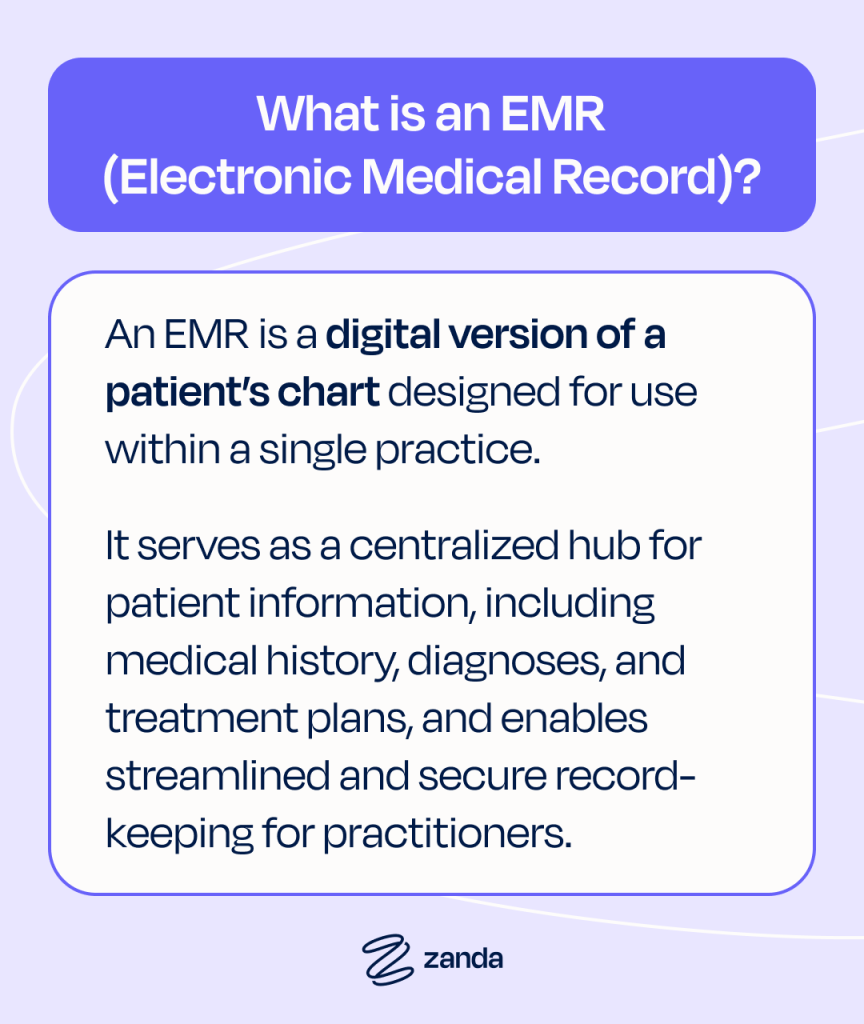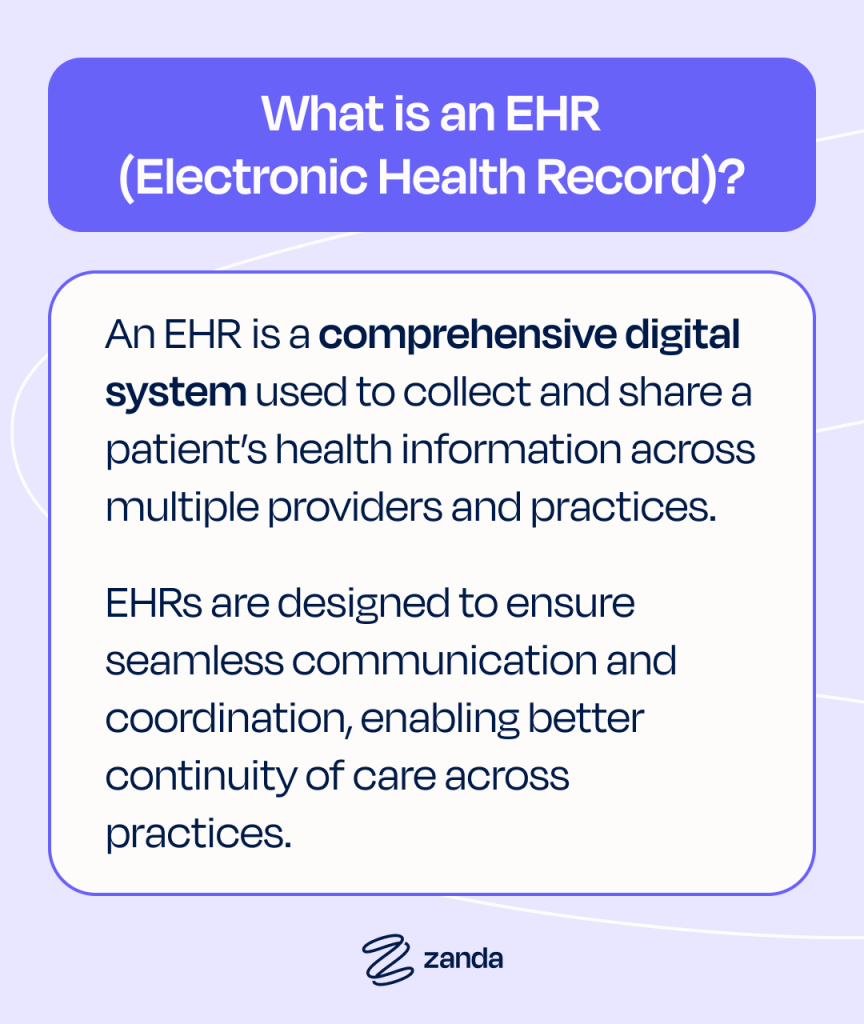The healthcare industry is undergoing a digital transformation that’s changing how patient information is managed and accessed.
At the heart of this shift are EMRs (Electronic Medical Records) and EHRs (Electronic Health Records) – two terms often used interchangeably but with distinct meanings and applications.
In this article, we’ll break down the differences between EMRs and EHRs, clarify their roles in healthcare, and help you determine which one best supports your practice’s needs.
Let’s cut through the confusion.
What is an EMR (Electronic Medical Record)?
An EMR, or Electronic Medical Record, is a digital version of a patient’s chart designed for use within a single practice or healthcare facility. It serves as a centralized hub for patient information, including medical history, diagnoses, and treatment plans, and enables streamlined and secure record-keeping for practitioners.
Key Features of EMRs
- Single Practice Scope: EMRs are used exclusively by one practitioner or practice, ensuring all patient data is specific to the practice.
- Comprehensive Patient Information: EMRs are digital versions of a patient’s chart. They include critical details such as medical history, diagnoses, prescriptions, treatment plans, and test results.
Benefits of EMRs
- Improved Storage: EMRs eliminate the need for physical files. This reduces clutter and the risk of data loss.
- Reduced Operational Costs: Digitizing patient records helps practices save money on storage and administrative tasks, which frees up resources for patient care.
For example, a physical therapist could use an EMR to securely document a patient’s visits, treatment plan, and take-home exercises. This ensures all of the patient’s information stays organized and accessible within the practice, facilitating consistent, personalized care.
What is an EHR (Electronic Health Record)?
An EHR, or Electronic Health Record, is a comprehensive digital system used to collect and share a patient’s health information across multiple providers and practices. EHRs are designed to ensure seamless communication and coordination, enabling better continuity of care across practices.
Key Features of EHRs
- Shared Health Information: EHRs consolidate data from labs, imaging centers, specialists, and patient portals, making it accessible across different healthcare settings.
- Interoperability: EHRs are built to facilitate information sharing between practices, so providers can collaborate effectively on a patient’s care.
Benefits of EHRs
- Supports Coordinated Care: EHRs can connect multiple practices, ensuring everyone involved in a patient’s care has access to the same up-to-date information.
- Facilitates Population Health Management: EHRs enable practices to analyze data trends, improve patient outcomes, and manage health on a larger scale.
For example, a patient’s EHR could allow their primary care doctor, cardiologist, and local hospital to access their medical history, test results, and treatment plans. This ensures the care team stays connected and provides the best support. EHR data can help providers across different practices avoid the duplication of tests.
Key Differences Between EMR and EHR
To choose the right system for your practice, you’ll need to understand the differences between EMRs and EHRs. While both tools digitize patient information, their scope, capabilities, and purposes differ significantly.
Scope
- EMR: Focuses solely on documentation within a single practice, keeping all data contained for internal use.
- EHR: As HealthITbuzz puts it, “The information moves with the patient…”. EHRs provide a holistic view of a patient’s health, integrating and sharing information from multiple providers and facilities.
Exchange and Use of Information
- EMR: Sharing data between practices is limited, as EMRs are not designed for interoperability.
- EHR: Enables seamless information exchange, helping ensure that all healthcare providers involved in a patient’s care have access to the same data.
Purpose
- EMR: Serves as a digital replacement for paper charts, primarily for internal use within one practice.
- EHR: Facilitates collaboration across multiple practices, supporting coordinated and comprehensive care.
Why Does the Distinction Matter?
Understanding the difference between EMRs and EHRs is more than terminology. It’s about the impact on your administrative processes, patient care, and meeting regulatory standards for your industry.
Impact on Patient Care
- EHRs: Enhance continuity of care by allowing seamless sharing of information between practices. This reduces duplication of tests and ensures providers have access to the same comprehensive data.
- EMRs: Focus on single-practice documentation, ideal for practices that don’t require extensive collaboration with external providers.
Regulatory Requirements
- EHRs: Often meet federal interoperability and Meaningful Use standards, which are essential for practices participating in US government incentive programs like Medicare and Medicaid. These standards ensure that healthcare data can be exchanged efficiently and responsibly to improve patient outcomes.
- EMRs: May not fully meet these standards, limiting their ability to support practices needing compliance with such regulations.
The choice between an EMR and an EHR depends on the scope and needs of your practice. The distinction has a direct impact on patient care and operational compliance.
How to Choose Between EMR vs EHR
The right system for your practice will be the one that best meets your needs. At Zanda, we like to say, don’t let software slow you down.
Factors to Consider
- Practice Size and Complexity: Practices that collaborate extensively with external providers, like General Practitioners or hospital-based practices, may benefit from an EHR, which supports more comprehensive data sharing and collaboration. Private allied health practices or practices with multiple specialties under one roof might find an EMR sufficient for their needs.
- Need for Data Sharing: If your practice regularly collaborates with multiple external specialists, hospitals, or healthcare facilities, an EHR may be the better choice for seamless data exchange.
- Budget and IT Infrastructure: EMRs tend to be more affordable and simpler to implement, whereas EHRs can require more complex IT infrastructure and ongoing support.
Tips for Evaluation
- Look for Security Compliance: Make sure the system complies with industry security standards, such as HIPAA, to protect patient data.
- Consider Vendor Support and Training Options: Evaluate the level of support and training the vendor offers to ensure a smooth transition and continued success with the system.
Your Practice, Our Priority
If you’re going digital, choose software that centralizes all your practice’s most important functions on one platform.
Zanda is practice management software that makes it all simpler.
- Scheduling: Our scheduling system allows you to manage appointments efficiently.
- Clinical Notes and Charts: Zanda includes clinical note templates that streamline record-keeping so you can document and retrieve information easily.
- Online Forms: Secure, configurable online forms make data collection seamless.
- Room and Resource Booking: It’s simple to add, edit, or allocate resources in Zanda.
- Billing and Claiming: Automated invoicing and integrated claiming features streamline admin and improve your cash flow.
- Security: Zanda prioritizes data security with ISO 27001-certified compliance measures.
Ready To Run Your Practice On Your Terms?
Experience how Zanda can support your unique needs and help your practice thrive.
Start a 14-day free trial today! No credit card required.







